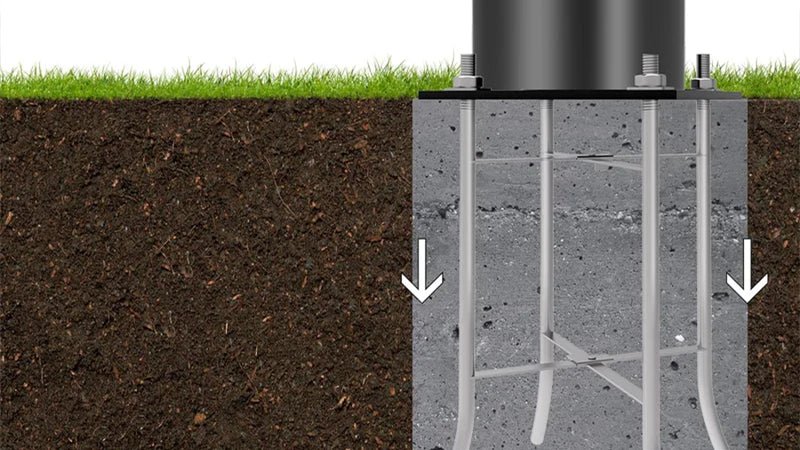Geographical and climatic diversity of different states requires tailored approaches to ensure the durability and functionality of light pole installations. Let's explore the specific considerations for installing light poles in different regions of the U.S., focusing on states with similar geographical factors, including drilling specifications such as depth and diameter.
1. Understanding Regional Geography and Climate:
a. Coastal States (e.g., California, Florida)
Coastal proximity and saltwater exposure in states like California and Florida pose unique challenges for light pole installations. The corrosive effects of saltwater require the use of corrosion-resistant materials such as stainless steel or aluminum. Additionally, high wind loads necessitate deep drilling and robust anchoring techniques to ensure stability in coastal environments.
b. Mountainous States (e.g., Colorado, Montana)
Rocky terrain and heavy snow loads characterize mountainous states like Colorado and Montana. Specialized drilling equipment and techniques are required to anchor light poles securely in rocky terrain. Snow load considerations are crucial, requiring increased pole height and structural reinforcement to withstand heavy snow accumulation.
c. Plains States (e.g., Kansas, Nebraska)
Flat terrain and prevailing winds influence light pole installations in plains states such as Kansas and Nebraska. Soil stability assessments are essential for determining drilling depth and diameter, particularly in areas prone to soil erosion or subsidence. Appropriate anchoring methods, such as concrete footings or ground screws, must be selected to ensure stability in high wind conditions.

2. Understanding Soil Properties
a. Coastal States (e.g., California, Florida)
Coastal regions often have sandy soil due to erosion from ocean waves. Sandy soil requires wider diameters and deeper footings to compensate for its low load-bearing capacity. Special attention must be given to moisture content, as high tides and rainfall can saturate the soil, affecting stability.
b. Mountainous States (e.g., Colorado, Montana)
The mountainous terrain is characterized by rocky soil, presenting challenges for drilling. Specialized equipment, such as rock augers or pneumatic hammers, is required to penetrate the hard ground. Soil composition analysis is crucial to determine rock density and stability for anchoring light poles securely.
c. Plains States (e.g., Kansas, Nebraska)
Plains states may have varying soil types, including clayey soil in some regions. Clayey soil is dense and compacted, requiring deeper drilling and specialized anchoring techniques for stability. Soil compaction tests and bearing capacity evaluation are essential to assess soil stability and ensure adequate anchoring.

3. Understanding Moisture Content:
Coastal regions experience high moisture content due to proximity to the ocean and frequent rainfall. Wet soil conditions can affect soil stability and compaction, necessitating adjustments to drilling depth and diameter. Soil composition analysis and moisture content measurements are essential for accurate assessment.
a. Mountainous States
Moisture content in mountainous regions varies depending on elevation and precipitation patterns. Wet soil conditions can occur during snowmelt or heavy rainfall, affecting drilling operations and soil stability. Bearing capacity evaluation is critical to determine the impact of moisture content on soil stability.
b. Plains States
Soil moisture content in plains states may fluctuate depending on precipitation levels and drainage patterns. Dry soil conditions are common in arid regions, resulting in increased soil density. Soil compaction tests and moisture content analysis are essential to determine drilling specifications and anchoring methods.

4. How to install light poles
a. Site Assessment
Soil composition, drainage patterns, and potential obstructions must be evaluated before installation. Identification of underground utilities is essential to avoid damage during drilling
b. Soil Testing
Soil testing determines load-bearing capacity and stability, guiding adjustments to drilling specifications based on soil test results.
c. Installation Process
Appropriate drilling equipment and concrete mixing techniques are essential for creating durable footings. Proper alignment and leveling of poles ensure uniformity and stability.
d. Pole Erection
Installation of base plates and anchoring systems according to manufacturer specifications is crucial for stability and safety.
5. Diameter Recommendations
Coastal states require larger-diameter drilling to accommodate corrosion-resistant materials and provide stability against high winds and saltwater exposure. In mountainous regions, adequate diameter sizing enhances pole stability in rocky terrain and snow-prone areas. Plains states should consider soil type and wind load factors when determining drilling diameter.
6. Depth Recommendations
a. Coastal States
Deeper drilling is required in coastal regions to reach stable substrate layers and ensure adequate anchoring. The presence of sandy soil and high moisture content may necessitate even deeper drilling to prevent settling and erosion.
b. Mountainous States
Specialized drilling equipment is necessary for penetrating rocky terrain and achieving sufficient depth for anchoring. Consultation with geotechnical engineers is recommended to assess rock density and stability for anchoring light poles securely.
c. Plains States
Clayey soil in plains states may require deeper drilling to reach stable layers and ensure adequate support for light poles. Soil compaction tests and bearing capacity evaluation are essential for determining drilling depth and diameter in flat terrain with occasional high winds.
6. Diameter Guidelines
Wider diameters are necessary in coastal regions to distribute load and minimize settling in loose sandy soil conditions. Larger-diameter drilling accommodates compacted soil and provides ample support for light poles against coastal winds and saltwater exposure.
a. Mountainous States
Adjustments to drilling diameter are based on rock density and stability in mountainous terrain. Specialized drilling equipment may be required to accommodate rocky soil conditions and achieve sufficient anchoring depth.
b. Plains States
Drilling diameter is determined based on soil composition and wind load factors in plains states. Soil compaction tests and moisture content analysis inform diameter guidelines to ensure stability in flat terrain with occasional high winds.
7. Conclusion
By tailoring light pole installation approaches to the specific geographical and climatic conditions of diverse U.S. states, stakeholders can ensure the reliability and longevity of outdoor lighting systems. Through careful consideration of drilling specifications, pre-installation preparation, and compliance with regulations, installers can navigate regional challenges and create safe, well-lit environments across the nation.


































Leave a comment
This site is protected by hCaptcha and the hCaptcha Privacy Policy and Terms of Service apply.